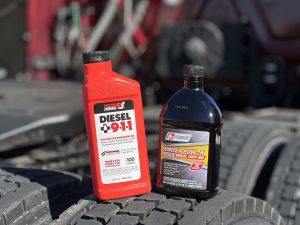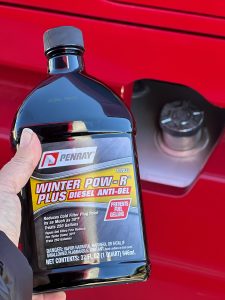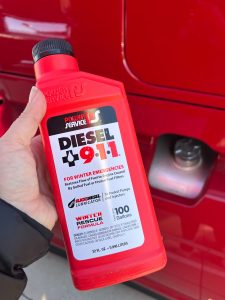Winter Fuel Care Guide for Truck Drivers | Keep Your Rig Running Smoothly
Winter weather brings many challenges for truck drivers. One of those challenges is making sure your fuel is treated any time the temperature gets below 20 degrees. While you can purchase pre-treated fuel in some areas, it is going to be less common in southern states.

Ignoring this part of the process can cost you more time and mo
ney down the road. Once your truck is totally gelled up, there is a chance that even the products we recommend won’t be able to help you. At that
point, you are looking at a tow bill instead of the price of pre-treating your f
uel. While these extra costs add up, they are still more affordable than a tow and the work lost due to your truck being out of operation.
How Cold Temperatures Affect Diesel Fuel
There is a small amount of water in diesel fuel. If that water starts freezing up, eventually it will get cold enough to solidify. This begins to happen once the temperature drops below 20 degrees. This means the fuel can no longer flow freely through lines and filters which can lead to additional problems in the future. If not addressed, your truck could stop running all together.
When and How to Treat Fuel During Winter Months
 To keep things from gelling up, you should be treating your tractor with Anti-Gel any time the temperature drops below 20 degrees. Anti-gel works by lowering the freezing point of your fuel. If you are fueling up in the south and driving north, it is best to assume that the fuel has not been treated. Be sure you follow the directions on the bottle, but here are our recommendations:
To keep things from gelling up, you should be treating your tractor with Anti-Gel any time the temperature drops below 20 degrees. Anti-gel works by lowering the freezing point of your fuel. If you are fueling up in the south and driving north, it is best to assume that the fuel has not been treated. Be sure you follow the directions on the bottle, but here are our recommendations:
A one quart bottle of anti-gel will treat 250 gallons of fuel. So one bottle can be used on both 100 gallon tanks on your truck and to fill the reefer unit.
Add the anti-gel to your tanks and let it run through the reefer fuel lines for 2 hours.
For every 20 degrees the temperature drops after that, you will need to add another treatment. If it is zero degrees, then you should add two bottles of anti-gel. Heading into Wyoming where temperatures can drop to -40 degrees? You will need 4 bottles to treat your fuel and drop the freezing point enough to keep you on the road.
Signs Your Fuel has Gelled Up
Your bunk heater is the first think that will freeze up during cold weather. There is a small fuel line that goes underneath the cab and connects to both the APU and the bunk heater. It is exposed to the elements and the cold air as you drive. If you are a reefer driver, the reefer unit will be the next problem area. These are warning signs to take care of the problem quickly.
How to Treat Fuel that is Already Gelled Up
 If you didn’t pre-treat your truck and your fuel gels up, your truck may stop operating. Now it is time to do an emergency treatment. We recommend Diesel 911. At this point, you have to treat the entire truck; not just the fuel in the tanks. This process can take 4 to 5 hours because instead of treating the fuel in your tanks, you are treating the fuel in the rest of your fuel system.
If you didn’t pre-treat your truck and your fuel gels up, your truck may stop operating. Now it is time to do an emergency treatment. We recommend Diesel 911. At this point, you have to treat the entire truck; not just the fuel in the tanks. This process can take 4 to 5 hours because instead of treating the fuel in your tanks, you are treating the fuel in the rest of your fuel system.
Add Diesel 911 and let everything run for 4-5 hours. This process takes more time because you have to treat the whole truck; not just the fuel in the tanks. The Diesel 911 needs to run through the fuel lines, fuel filters, injectors, and engine. This requires you to run the truck long enough to pull the fuel out of the tank and run it through your entire fuel system. If you are a reefer driver, you will also need to treat the reefer unit with Diesel 911. For more information on how to use Diesel 911 properly, please consult their directions.
If your truck is no longer running, you will also need to pull the fuel filter and add Diesel 911 to the filter. At this point, it may be too late though. During this time, make sure you also run your bunk heater non-stop for two to three hours. That is how long it takes to pull fuel out of the fuel tank and go all the way into the bunk heater burner. Your reefer unit will also need to run for two hours. The fuel on your reefer tank is about 30 feet behind the reefer itself. There is a lot of fuel lines connecting the tank to the reefer. The fuel needs to move throughout all of these lines.
If Diesel 911 doesn’t do the trick, it is time to call for a tow. Your truck will need to sit inside a warm shop to thaw out and let the emergency treatment run through the fuel lines.
 Stock up on these products before you head into areas with low temperatures. If you gel up on a cold day in Wyoming, there’s a pretty good chance the shelves are going to be empty. -Doug Tamm, Prime Road Assist and Tire Manager
Stock up on these products before you head into areas with low temperatures. If you gel up on a cold day in Wyoming, there’s a pretty good chance the shelves are going to be empty. -Doug Tamm, Prime Road Assist and Tire Manager
Pre-treat your fuel if you think there is any chance you are heading into cold temperatures. It is so much cheaper than a tow. -Ben Littleton
Treating your fuel during the winter months is another added cost to drivers. Make sure you are offsetting that cost by looking for ways to save money in your business. One option is the Prime Advantage Plus fuel card. It doesn’t just save on fuel but also maintenance costs. -Rick Shortt, Pedigree Marketing Manager

